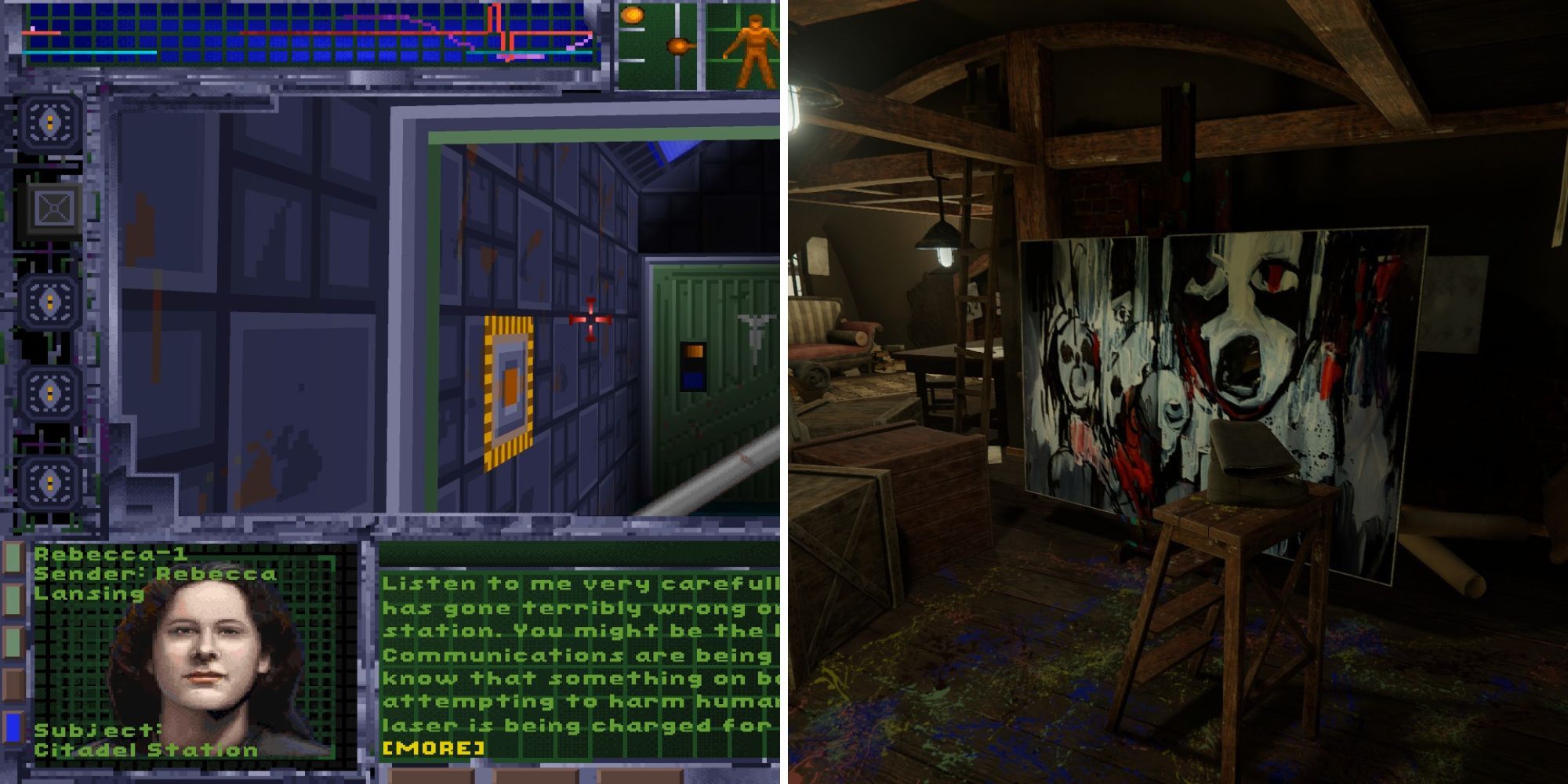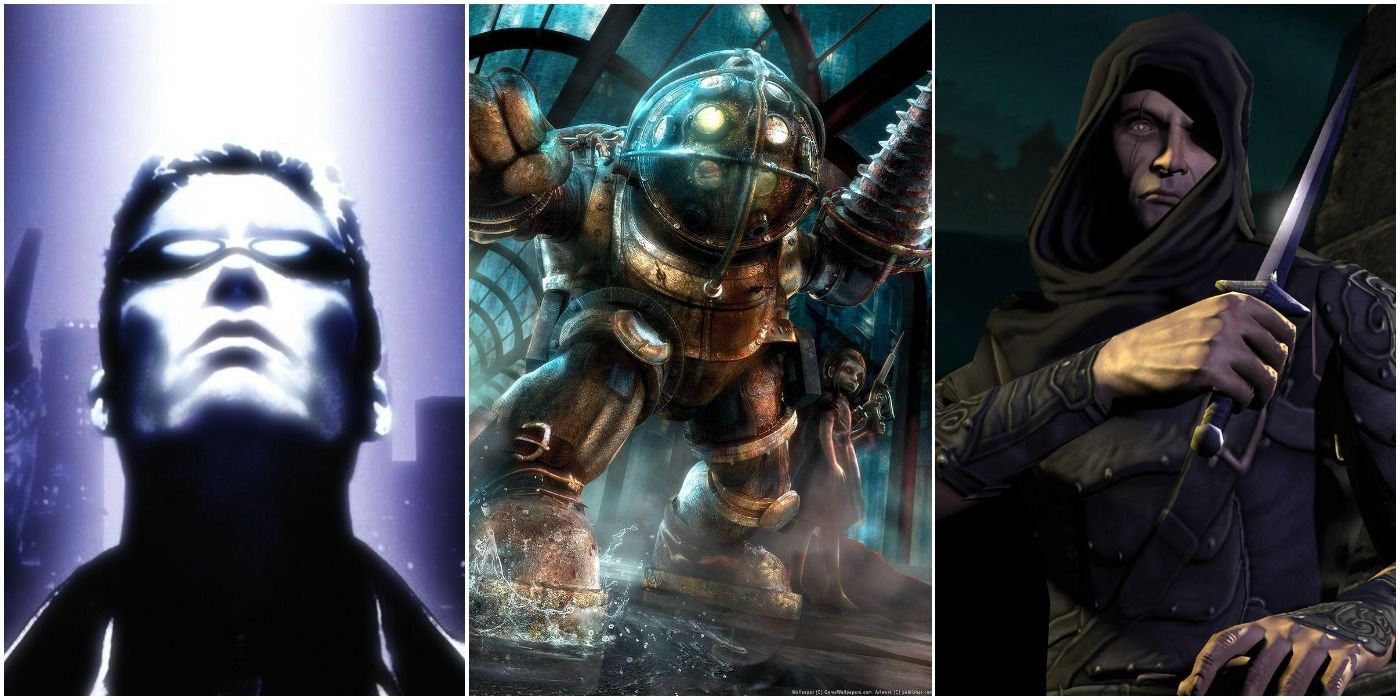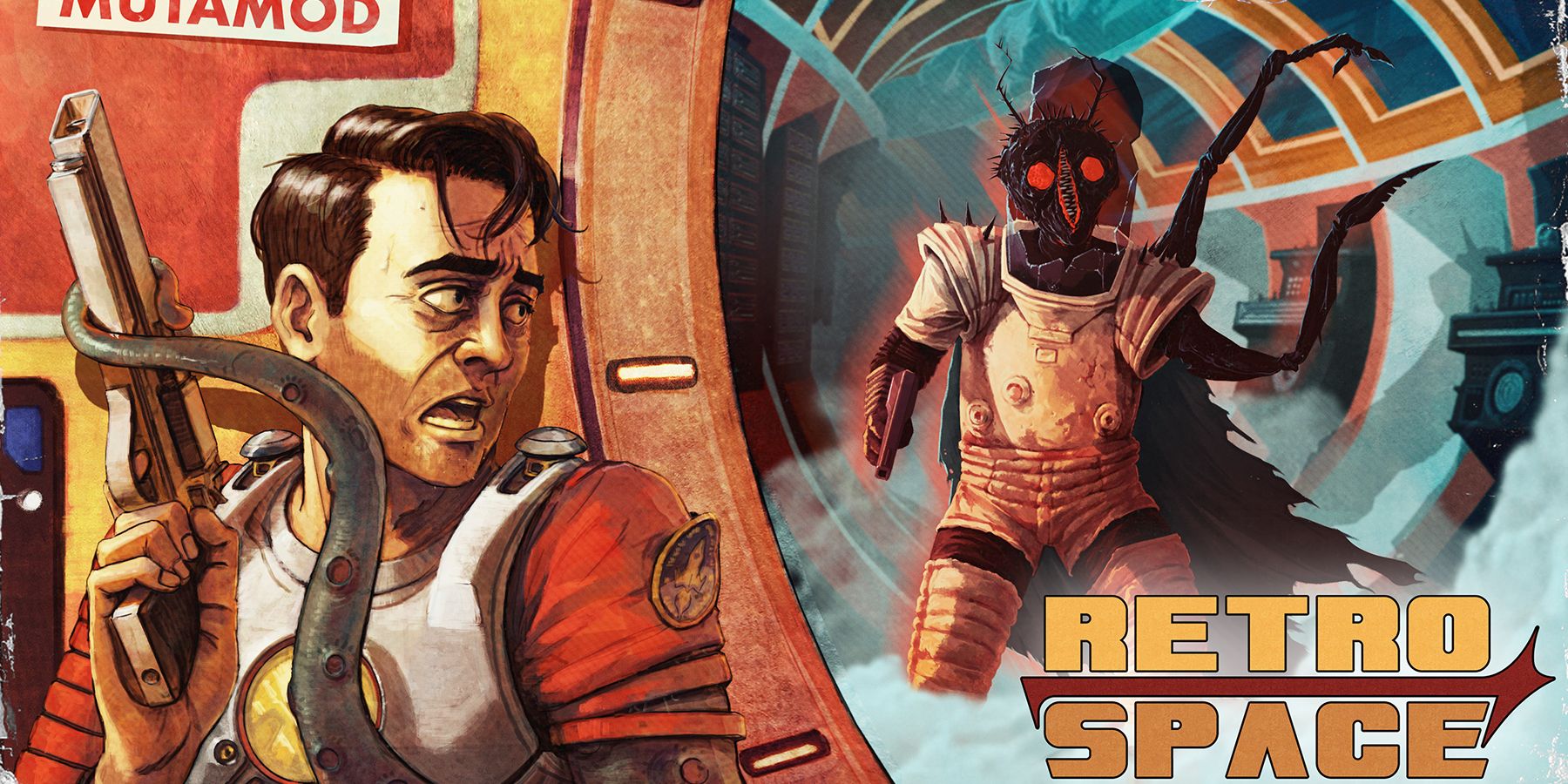RetroSpace is an upcoming first-person immersive sim that harkens back to the genre's glory days, when games like Half-Life, Deus Ex, and System Shock were testing players' critical thinking skills as often as their shooting reflexes. In this indie immersive sim, players will need to have their wits about them as they navigate a freely explorable disco-punk space station crawling with terrifying creatures that appear to draw inspiration from horror film staples like The Thing, all while managing limited resources and engaging in the creative problem-solving this genre is famous for.
Game ZXC spoke with Bálint Bánk Varga, RetroSpace's writer and designer, about how the team at The Wild Gentlemen has approached developing many of the game's systems. He spoke about the team's approach to open-ended immersive sim design and enabling "pacifist runs," how they go about designing a complex and interconnected space station, and some of the features that players can look forward to when the game launches. The interview has been edited for brevity and clarity.

8 Great Immersive Sims That Are Short & Sweet
Not every player enjoys long and drawn-out games, some enjoy short and sweet sims that do a fantastic job at immersing players into the game
RetroSpace's Immersive-Sim Design Philosophy
Q: In a recent devlog, it was said that the team wanted to create something new yet nostalgic. Can you talk about some of those nostalgic elements? What is it about those classic games that you want to revisit?
Varga: RetroSpace was inspired by games such as Thief and Thief 2, System Shock 2, Deus Ex, or Half-Life. They all have unique elements that we love, but they also have some very important things in common. From a gameplay perspective, these games let the player be free and allow them to experiment with their systems. Even the rather linear Half-Life throws you into an imaginary sandbox where, without any guidance or help, you have to explore the world around you and experiment with its elements.
This is even more true for games closer to the immersive sim style. One of the nostalgic feelings we're looking for is the mystique that these games represented and the fact that they didn't hold the player by the hand, or poke their eye out with tutorial windows or quest markers. They dared to leave you alone in a place where you had to manage by yourself.
The other, probably more obvious aspect is the graphical style. We wanted the game to look very nostalgic, with low-poly models and pixelated textures, but with more modern effects. Essentially, our philosophy was that the game should look the way we remember the old games, not the way they really were.
Q: RetroSpace features immersive sim-style gameplay, allowing players to take various creative approaches to problems. What challenges do you face when developing an open-ended game like this, and how do you tackle those?
Varga: This is almost impossible to list. When you make a game like this, the level design has to be fully adapted to this philosophy, but you also have to build the narrative, the elements of your story, on top of that. Basically, you need to adapt every system or gameplay feature to this because this is a highly interconnected, intricate system. You have to let the player be free, but you still have to give them some direction. You have to direct their focus in a way that feels so natural that they almost don't notice.
Also, of course, an immersive sim system has a general multiplier of 10. In other words, take the AI, the physics, or any other aspect of the game and multiply it up to 10 to get the level of problems that come with developing an immersive sim game. This can be a very high level of suck, but to be more positive, the result will also be 10 times more captivating, unique, and of course, immersive.
Q: RetroSpace appears to have metroidvania-style interconnected level design. How will players progress through the game's areas in metroidvania terms? Will certain abilities open up new areas to explore?
Varga: We'll be on a fairly open and free-to-explore space station, but new areas will keep opening up, often in places we've been before but for some reason couldn't get further. These can be opened up as the story unfolds or as a result of an item or ability you've acquired. So in that respect, we're following a classic Metroidvania-like formula. We want the player to visit most of the locations in the game not just once but return to them several times, opening up new sub-locations, secret routes, shortcuts, and such.
Q: There's been a lot of discourse recently surrounding the "yellow paint" approach to guiding players. How does RetroSpace approach leading players to points of interest or potential solutions within the environment?
Varga: The "yellow paint" approach can work perfectly well for games where the player only needs to move forward and where getting stuck in a spot for even a minute is NOT an integral part of the game experience. In an action game, if you get stuck in a room for a moment, you already feel frustrated because you're almost playing an interactive movie and these moments of hesitation can feel alien.
However, in a more open, free game like an immersive sim, such "aggressive" cues like the yellow paint method can feel strange and immersion-breaking precisely because it's part of the core experience that you have to find your own path forward. You have to explore your environment; you have to essentially get lost to be immersed in the game's world completely. That said, we feel the trend has become a little too extreme, and in some games, you feel your intelligence is being insulted by how blatantly you are told what to do or what to interact with.
Our first rule is: never take the player for a fool. Respect their intelligence and they will respect your game in return.
Q: How did you approach the game's Mutamods system? How do you decide which abilities to include or how they're balanced?
Varga: Balancing such systems is always very difficult. In RetroSpace, there will be Mutamods (mutations, essentially superpowers), and there will also be tech upgrades, which are all sorts of technical gadgets that give the player other kinds of extra abilities. In addition, Mutamods are not just offensive skills. There are many different active and passive abilities that give some sort of advantage, and since the player can pick and choose which of the acquired skills to use at the same time, all sorts of combos can be formed.
We also have to take into account that there will be sneaking purists who will deliberately want to play the game without any abilities, and we want to balance the systems so that they have a chance too. This is an extremely difficult and complex task, but also a lot of fun. There are no tried and tested formulas; there's a lot of trial and error and testing in all sorts of combinations. And even so, you can't rule out the possibility that players might find a weapon/mutamod/tech-upgrade super combo that essentially breaks the game, but that's okay. It's somewhat inherent to the genre.
Q: Can you talk about the game's unique death and rebirth system? What are some ways that this can shake up gameplay for players between deaths?
Varga: We deliberately don't want to talk too much about this so that there's some surprise, but essentially what we're doing is that when the player dies, a clone will continue the game, who unfortunately will get some sort of debuff, which we call cloning degeneration. These often funny debuffs make the game more difficult (or push the player out of their comfort zone) until they reach their own corpse. There, you'll have the opportunity to regain your old genome, meaning you can get rid of any negative effects, but here's a twist we don't want to give away: a surprise will wait for you when you get to your previous body.

10 Immersive Sims To Play If You Loved The Original BioShock
The original BioShock was an immersive game that left a hole in the hearts of many. Here are other awesome games to fill it.
Stealth, Horror, and Exploration in RetroSpace
Q: How does stealth play out in RetroSpace? Can you talk about the ways players can covertly approach objectives? Have you factored in unusual approaches like "pacifist runs"?
Varga: Absolutely! One of the first things we've laid down is that the game can be played in a completely pacifist way, without eliminating a single opponent. This will be extremely difficult, of course, but there will be mutamods and tech upgrades that will make this approach much easier. In addition, all enemy types will be able to be lured away or trapped, so the player will have a lot of creative options for dealing with opponents other than just killing them. That's why we also try to build the levels in such a way that the observant players can always find alternative routes or, if not, make them for themseves.
Q: What's RetroSpace's approach to horror? How do you try to evoke fear and tension in players as they explore the station?
Varga: We want to avoid cheap solutions and only very rarely use jumpscares, for example. Our approach is twofold: the first is continuous tension building. We hear or see the opponents first from a distance, so we lead them up thoroughly before they jump on the player. We will see their signs and traces first, encountering what they can do before we encounter the creatures themselves. Also, the whole world (station) has a sense of "there was real, flourishing life here minutes ago, yet everything is dead now," which is a very strangely scary feeling. The traces of life will be everywhere as if we are just minutes too late from a catastrophe that changed everything.
On the other hand gameplay-wise, the horror will be brought on by the toughness of our opponents and the scarcity of our resources. We will constantly fear for our lives and the things we have gathered for ourselves.
Q: What's your approach to enemy design in RetroSpace? Do you come up with a gameplay role for an enemy and then design around that, or do you start with visual inspiration and then determine its abilities and behavior from there?
Varga: Both ways can work. Sometimes, the first thing that came to mind was the creature design, as in the case of Mothmanaut, which is a kind of "moth mutant." In his case, what he would look like came first and only then did we start to figure out his unique behavior and abilities. What does a moth do? It follows the light. From that came the idea that they could be distracted by light, and that their more advanced forms would even be healed by light.
But the other direction also happened. We had an exciting mechanic come to us first, and then we came up with a design. What kind of creature will smell blood and corpses from afar and follow the trail to the player? A pig? So in this case, the mechanics determined the art design and not the other way around.
Q: What's your process for designing a sprawling interconnected space station? Where do you even start?
Varga: We studied Metroidvania design and the level design philosophy of Soulslike games, especially the first Dark Souls. There should always be a hub of sorts where you can access multiple sections that you keep opening up, and you can always find shortcuts and secret paths. A lot of times, we'll show the player some kind of hint of where they can get to later to pique their curiosity, and then allow them to get there afterward but they have to do something or get something for it. It's a classic formula that is easy to define but hard to actually do right.
The game will open up nicely and steadily, and by the end, you will have a fully interconnected, completely traversable station as your playground. How do you design something like that? By a lot of planning, trial and error, and re-planning.
Q: By their nature, games like this are already heavily replayable by trying out new gameplay approaches. Will RetroSpace include other "replayability features" like randomized enemy placements, higher difficulty modes, or New Game+?
Varga: Yes. There'll be somewhat classic difficulty levels, there'll be New Game+, and there'll be unlockable gameplay mutators that can give players extra changes, and challenges. While we will recommend that players first play the game in the "normal way," it will be fascinating later on to create a completely unique experience for themselves with all sorts of gameplay-changing settings. In addition to that, the replayability will be enhanced by the fact that there will be several parts of the story where you will have to make a choice and where certain parts of the story will change as you make decisions.
Q: RetroSpace features a unique disco-punk aesthetic that isn't often seen in sci-fi or horror. What inspired this stylistic choice, and how has it affected your approach to things like environmental, weapon, or enemy designs?
Varga: First of all, we love this era and the classic science fiction books and films of this age. We wanted to bring a funny, funky, and colorful world to the player to show that love. We also realized that this era ('60s and '70s) is very under-represented in video games, which we feel is a bit unfair, but it also makes it easier to stand out from the crowd. We think horror can work when it's not just grey and black corridors. In fact, the vivid colors of the game add a rather absurd tone to the basic space-horror atmosphere. Design has also been very positively affected by this style choice, allowing us to create locations, weapons, objects, and enemies that depart from the classic sci-fi norms that have become commonplace.
[END]
RetroSpace is currently in development.









